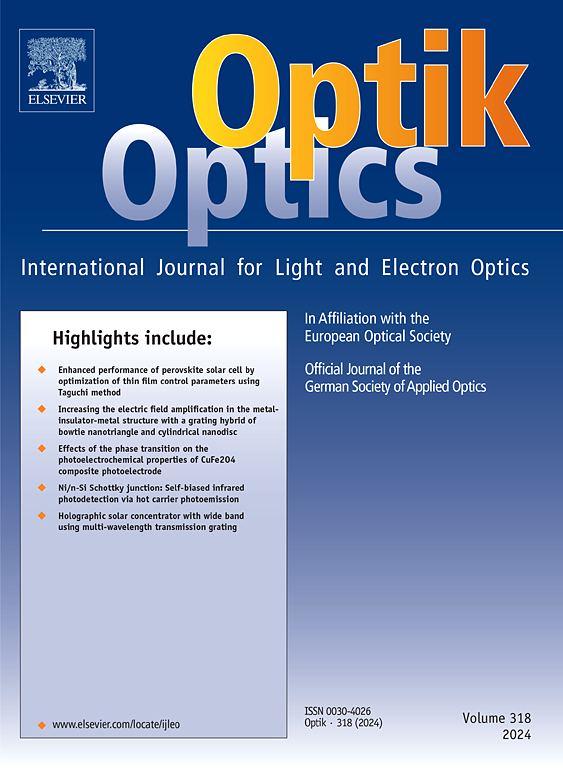Design, optimization, and evaluation of ultra-broadband hybrid optical doped-fiber amplifier for O+E+S+C band amplification
IF 3.1
3区 物理与天体物理
Q2 Engineering
引用次数: 0
Abstract
This study presents the design and optimization of a hybrid optical amplifier capable of amplifying optical signals in the O+E+S+C (multiband) wavelength bands. The amplifier’s architecture incorporates Praseodymium, Thulium, and Erbium-doped fiber amplifiers (PDFA, TDFA, and EDFA) connected in parallel configurations. The physical and geometric parameters of the amplifiers are tuned to achieve a signal gain 18 dB and a noise figure 4.91 dB for the wavelength region 1270 nm to 1560 nm. Additionally, the impact of the homogeneous up-conversion (HUC) ion-ion interaction mechanism on the signal gain is investigated and minimized by optimizing the amplifier’s physical and geometric characteristics. In the O and S+C bands, respectively, a gain deterioration of 2.3% and 4.6% is observed at 1310 nm and 1500 nm wavelengths. However, a gain increment of 0.48% in the E-band has been observed at 1380 nm. The performance of the multiband HOA is analyzed in coarse wavelength division multiplexing (CWDM), dense wavelength division multiplexing (DWDM), and ultra-dense wavelength division multiplexing (UDWDM) transmission links of an optical fiber communication system operating at data rates ranging from 5 to 10 gigabits per second (Gbps). The multiband HOA is installed as a pre-amplifier in the simulation set-up and assessed based on the quality (Q) factor. An errorless transmission with a Q-Factor 6.14 has been achieved for all the channels over a distance of 80 km of a single-mode fiber (SMF).
用于 O+E+S+C 波段放大的超宽带混合掺杂光纤放大器的设计、优化和评估
本研究设计并优化了一种能够放大O+E+S+C(多波段)波段光信号的混合光放大器。该放大器的架构采用了镨、铥和掺铒光纤放大器(PDFA、TDFA和EDFA)并联连接。对放大器的物理和几何参数进行了调整,以实现信号增益>;18db和噪声系数<;1270 ~ 1560 nm波长范围4.91 dB。此外,研究了均匀上转换(HUC)离子-离子相互作用机制对信号增益的影响,并通过优化放大器的物理和几何特性来最小化信号增益。在1310 nm和1500 nm波长处,O和S+C波段的增益衰减分别为2.3%和4.6%。而在1380 nm处,e波段的增益增加了0.48%。在数据速率为5 ~ 10gbps的光纤通信系统中,对粗波分复用(CWDM)、密集波分复用(DWDM)和超密集波分复用(UDWDM)传输链路中的多频段HOA性能进行了分析。在仿真设置中,多频段HOA作为前置放大器安装,并根据质量(Q)因子进行评估。带q系数的无差错变速器在80公里的单模光纤(SMF)中,所有信道都达到了6.14。
本文章由计算机程序翻译,如有差异,请以英文原文为准。
求助全文
约1分钟内获得全文
求助全文
来源期刊

Optik
物理-光学
CiteScore
6.90
自引率
12.90%
发文量
1471
审稿时长
46 days
期刊介绍:
Optik publishes articles on all subjects related to light and electron optics and offers a survey on the state of research and technical development within the following fields:
Optics:
-Optics design, geometrical and beam optics, wave optics-
Optical and micro-optical components, diffractive optics, devices and systems-
Photoelectric and optoelectronic devices-
Optical properties of materials, nonlinear optics, wave propagation and transmission in homogeneous and inhomogeneous materials-
Information optics, image formation and processing, holographic techniques, microscopes and spectrometer techniques, and image analysis-
Optical testing and measuring techniques-
Optical communication and computing-
Physiological optics-
As well as other related topics.
 求助内容:
求助内容: 应助结果提醒方式:
应助结果提醒方式:


